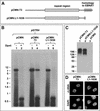The latency-associated nuclear antigen of Kaposi's sarcoma-associated herpesvirus permits replication of terminal repeat-containing plasmids
- PMID: 12552022
- PMCID: PMC141125
- DOI: 10.1128/jvi.77.4.2779-2783.2003
The latency-associated nuclear antigen of Kaposi's sarcoma-associated herpesvirus permits replication of terminal repeat-containing plasmids
Erratum in
- J Virol. 2003 Apr;77(7):4470
Abstract
The latency-associated nuclear antigen (LANA) of Kaposi's sarcoma-associated herpesvirus can associate with mitotic chromosomes and promote latent episome maintenance and segregation. Here we report that LANA also mediates the replication of plasmid DNAs bearing viral terminal repeats. The predicted secondary structure of LANA's C terminus reveals striking similarity to the known structure of the DNA-binding domain of Epstein-Barr virus EBNA1, despite the absence of primary sequence homology between these proteins, suggesting conservation of the key mechanistic features of latent gammaherpesvirus DNA replication.
Figures




Similar articles
-
The latency-associated nuclear antigen of Kaposi's sarcoma-associated herpesvirus supports latent DNA replication in dividing cells.J Virol. 2002 Nov;76(22):11677-87. doi: 10.1128/jvi.76.22.11677-11687.2002. J Virol. 2002. PMID: 12388727 Free PMC article.
-
Kaposi's Sarcoma-Associated Herpesvirus LANA-Adjacent Regions with Distinct Functions in Episome Segregation or Maintenance.J Virol. 2019 Mar 5;93(6):e02158-18. doi: 10.1128/JVI.02158-18. Print 2019 Mar 15. J Virol. 2019. PMID: 30626680 Free PMC article.
-
Mutational analysis of the latency-associated nuclear antigen DNA-binding domain of Kaposi's sarcoma-associated herpesvirus reveals structural conservation among gammaherpesvirus origin-binding proteins.J Gen Virol. 2010 Sep;91(Pt 9):2203-15. doi: 10.1099/vir.0.020958-0. Epub 2010 May 19. J Gen Virol. 2010. PMID: 20484563 Free PMC article.
-
The latency-associated nuclear antigen, a multifunctional protein central to Kaposi's sarcoma-associated herpesvirus latency.Future Microbiol. 2011 Dec;6(12):1399-413. doi: 10.2217/fmb.11.137. Future Microbiol. 2011. PMID: 22122438 Free PMC article. Review.
-
Kaposi's Sarcoma-Associated Herpesvirus Latency-Associated Nuclear Antigen: Replicating and Shielding Viral DNA during Viral Persistence.J Virol. 2017 Jun 26;91(14):e01083-16. doi: 10.1128/JVI.01083-16. Print 2017 Jul 15. J Virol. 2017. PMID: 28446671 Free PMC article. Review.
Cited by
-
Mechanism of angiopoietin-1 upregulation in Kaposi's sarcoma-associated herpesvirus-infected PEL cell lines.J Virol. 2015 May;89(9):4786-97. doi: 10.1128/JVI.03144-14. Epub 2015 Jan 28. J Virol. 2015. PMID: 25631079 Free PMC article.
-
A short sequence immediately upstream of the internal repeat elements is critical for KSHV LANA mediated DNA replication and impacts episome persistence.Virology. 2014 Jan 5;448:344-55. doi: 10.1016/j.virol.2013.10.026. Epub 2013 Nov 12. Virology. 2014. PMID: 24314665 Free PMC article.
-
Identification of properties of the Kaposi's sarcoma-associated herpesvirus latent origin of replication that are essential for the efficient establishment and maintenance of intact plasmids.J Virol. 2014 Aug;88(15):8490-503. doi: 10.1128/JVI.00742-14. Epub 2014 May 14. J Virol. 2014. PMID: 24829342 Free PMC article.
-
Maintenance of large numbers of virus genomes in human cytomegalovirus-infected T98G glioblastoma cells.J Virol. 2014 Apr;88(7):3861-73. doi: 10.1128/JVI.01166-13. Epub 2014 Jan 22. J Virol. 2014. PMID: 24453365 Free PMC article.
-
Kaposi's sarcoma-associated herpesvirus LANA protein downregulates nuclear glycogen synthase kinase 3 activity and consequently blocks differentiation.J Virol. 2007 May;81(9):4722-31. doi: 10.1128/JVI.02548-06. Epub 2007 Feb 21. J Virol. 2007. PMID: 17314169 Free PMC article.
References
-
- Arad, U. 1998. Modified Hirt procedure for rapid purification of extrachromosomal DNA from mammalian cells. BioTechniques 24:760-762. - PubMed
-
- Ballestas, M. E., P. A. Chatis, and K. M. Kaye. 1999. Efficient persistence of extrachromosomal KSHV DNA mediated by latency-associated nuclear antigen. Science 284:641-644. - PubMed
-
- Bochkarev, A., J. A. Barwell, R. A. Pfuetzner, E. Bochkareva, L. Frappier, and A. M. Edwards. 1996. Crystal structure of the DNA-binding domain of the Epstein-Barr virus origin-binding protein, EBNA1, bound to DNA. Cell 84:791-800. - PubMed
-
- Bochkarev, A., J. A. Barwell, R. A. Pfuetzner, W. Furey, Jr., A. M. Edwards, and L. Frappier. 1995. Crystal structure of the DNA-binding domain of the Epstein-Barr virus origin-binding protein EBNA 1. Cell 83:39-46. - PubMed
MeSH terms
Substances
LinkOut - more resources
Full Text Sources
Other Literature Sources

